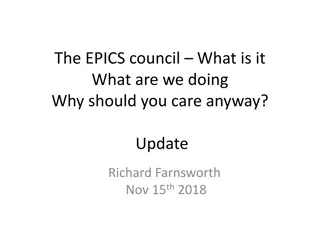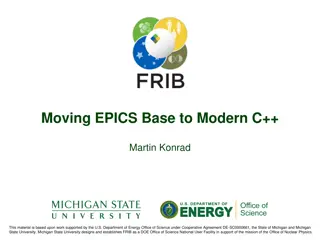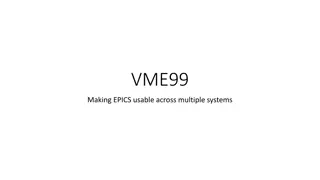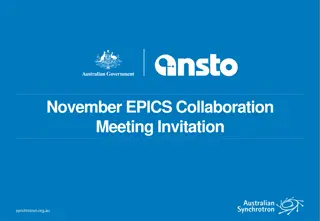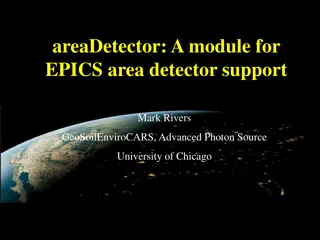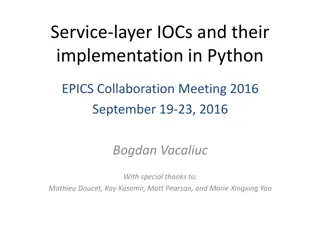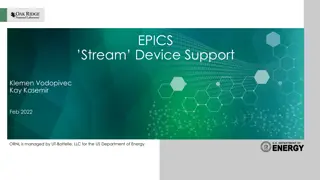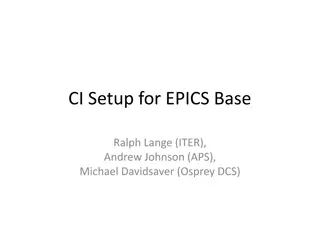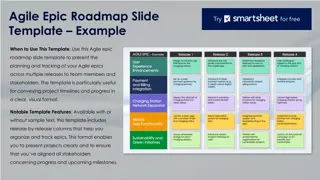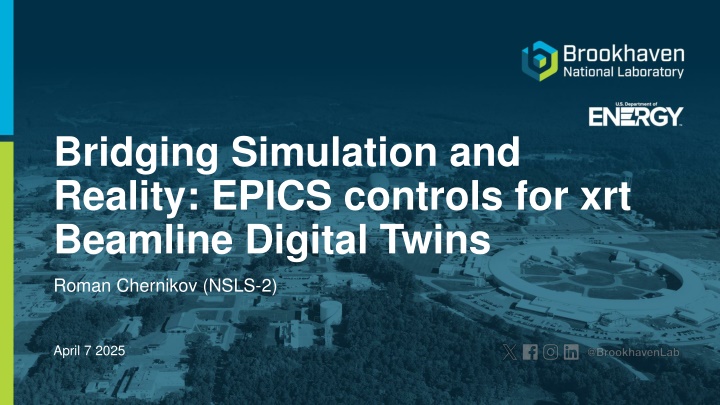
EPICS Controls for XRT Beamline Digital Twins Simulation
Explore how EPICS controls are utilized for X-ray propagation simulations in the xrt open-source Python-based optical simulation tool. Benefit from features like homogeneous environment, real-time calculations, GPGPU acceleration, and the xrtGlow 3D visualizer for beamlines rendering. Auto-generated PVs streamline the process further.
Uploaded on | 0 Views
Download Presentation

Please find below an Image/Link to download the presentation.
The content on the website is provided AS IS for your information and personal use only. It may not be sold, licensed, or shared on other websites without obtaining consent from the author. If you encounter any issues during the download, it is possible that the publisher has removed the file from their server.
You are allowed to download the files provided on this website for personal or commercial use, subject to the condition that they are used lawfully. All files are the property of their respective owners.
The content on the website is provided AS IS for your information and personal use only. It may not be sold, licensed, or shared on other websites without obtaining consent from the author.
E N D
Presentation Transcript
Bridging Simulation and Reality: EPICS controls for xrt Beamline Digital Twins Roman Chernikov (NSLS-2) April 7 2025
xrt open source, python-based optical simulation tool xrt is a free software library providing the tools for the X-ray propagation simulations from fast and accurate physical models to plotting and visualization instruments. Monte-Carlo integration technique is used to calculate the beam flux and power density. xrt can handle millions of rays: more rays means better accuracy and higher quality plots. 2
Features Homogeneous environment: rays generation, propagation and plotting controlled by single python script. All optical elements defined in global coordinate system No intermediate file operations , no maps or interpolation: all properties calculated for each ray in real time GPGPU accelerated calculations (OpenCL) Embedded material properties (reflection/refraction/absorption) Intensity in physical units from the source to the sample Propagation in rays, wave and hybrid mode GUI-aided script generation and 3D visualizer 3
xrtGlow 3D Visualizer for beamlines Rendering in OpenGL, Qt UI (greatly improved in v2) Independently scalable coordinate axes Orthographic* and perspective projections Adjustable color axis Selection of the beam segments / footprints to plot Rendered optical elements Movable virtual screen * Transition between local and global coordinate systems EPICS controls with pythonSoftIOC/asyncio * v2 implementation on the way 4
Auto-generated PVs TST:TM_HOR:R TST:TM_HOR:rotationSequence TST:TM_HOR:r TST:TM_HOR:limPhysX:lmin TST:TM_HOR:limPhysX:lmax TST:TM_HOR:yaw TST:TM_HOR:limPhysY:lmin TST:TM_HOR:limPhysY:lmax TST:TM_HOR:roll TST:TM_HOR:center:x TST:TM_HOR:center:y TST:TM_HOR:center:z TST:TM_HOR:pitch Orientation Shape Data TST:Screen1:image TST:Screen1:histShape:width TST:Screen1:histShape:height TST:Screen1:limPhysX:lmin TST:Screen1:limPhysX:lmax TST:Screen1:limPhysY:lmin TST:Screen1:limPhysY:lmax TST:Screen1:center:x TST:Screen1:center:y TST:Screen1:center:z 5
EPICS communication layer Dynamic update workflow 6
Acknowledgements and resources Team: Konstantin Klementiev (MAX IV) - xrt Max Rakitin (BNL) - bluesky, blop Thomas Morris (BNL) - blop Jennefer Maldonado (BNL) blop Thomas Hopkins (BNL) bluesky, blop Code: https://github.com/kklmn/xrt/tree/new_glow https://github.com/bluesky/bluesky https://github.com/NSLS-II/blop https://github.com/yxrmz/blop-xrt-examples Demo: https://www.youtube.com/watch?v=dSkXGknYDmc https://www.youtube.com/watch?v=FfMAghtL6E0 8

